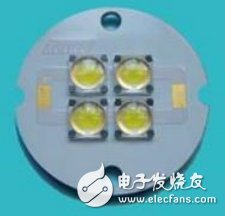At present, the common types of substrates are hard printed circuit boards, high thermal conductivity aluminum substrates, ceramic substrates, flexible printed circuit boards, metal composite materials, etc. Generally, the low-power LED package can meet the demand by using the PCB version used in the general electronics industry. However, most LED packages over 0.5W use metal-based and ceramic-based high heat dissipation substrates. The performance has a direct impact, so the packaging substrate becomes a very important component when designing high-brightness LED commodity applications.

In the general process of converting electricity into light, nearly 80% becomes heat. With so much heat, it is impossible to completely dissipate that much heat by two pins. We rely on heat sinks to dissipate heat. In fact, a lot of heat will not burn off particles in such a small space, but it will make the light weaker and weaker, which is what we usually call light decay. Only when the heat is dissipated faster, the light attenuation is smaller.
Below, we only discuss the application advantages in LED components from the three aspects of heat dissipation, thermal expansion, and dimensional stability of metal packaging substrates:
1. Heat dissipation
At present, many double-sided and multi-layer boards have high density and high power, making it difficult to dissipate heat. Conventional printed circuit board substrates such as FR4 and CEM3 are thermally poor conductors, insulated between layers, and the heat cannot be dissipated. Local heating of electronic equipment is not ruled out, resulting in high temperature failure of electronic components, and metal-based printed boards can solve this heat dissipation problem.
2. Thermal expansion
Thermal expansion and contraction are the common nature of materials, and different materials have different CTE (Coefficient of Thermal Expansion) or thermal expansion coefficients. The printed board is a composite of resin + reinforcement material (such as glass fiber) + copper foil. In the XY axis direction of the board surface, the thermal expansion coefficient (CTE) of the printed board is 13 ~ 18 PPM / ℃, in the Z axis direction of the board thickness is 80 ~ 90PPM / ℃, and the CTE of copper is 16.8PPM / ℃. The CTE of the chip ceramic chip carrier is 6PPM / ℃. The CTE of the metalized hole wall of the printed board and the connected insulating wall are very different in the Z axis. The generated heat cannot be eliminated in time. , Disconnect, so that the machine equipment is not reliable.
SMT (Surface Mount Technology) makes this problem more prominent and becomes an indispensable problem. Because the surface mount interconnection is achieved by direct connection of the surface solder joints, the ceramic chip carrier CTE is 6, and the FR4 substrate in the XY direction CTE is 13 ~ 18. Long-term stress will cause fatigue fracture.
The metal-based printed board can effectively solve the heat dissipation problem, thereby alleviating the thermal expansion and contraction of different substances of the components on the printed board, and improving the durability and reliability of the whole machine and electronic equipment.
3. Dimensional stability
Metal-based printed boards are obviously much more stable than printed boards made of insulating materials. Aluminum-based printed boards and aluminum sandwich panels are heated from 30 ° C to 140-150 ° C, and the dimensional change is 2.5-3.0%. The metal-based circuit board has excellent thermal conductivity, good machining performance and strength, good electromagnetic shielding performance, and good magnetic performance. The product design follows the semiconductor thermal conduction mechanism, so not only the thermally conductive metal circuit board (metal PCB): aluminum substrate and copper substrate have good thermal conductivity and heat dissipation. Moreover, it is green and environmentally friendly, which not only solves the problem of heat but also the problem of polluting the environment.
iPhone 7 Plus Battery Pack, OEM Li-ion Polymer 3.82v 2900mAh with 1 year warranty. iPhone Replace Battery Pack daily production 100-150,000pcs, defective rate below 3‰. Our factory produced iPhone Battery Pack have passed CE,RoHS,MSDS,UN38.3 and IEC 62133.
Nominal voltage: 3.82V
Limited charge voltage: 4.35V
Capacity: 2900mAh (11.10whr)
Cell size: 32x49x119mm
iPhone 7 Plus Battery
iPhone 7 Plus Battery Pack,iPhone 7 Plus Battery Pack Replacement,Battery Pack For iPhone 7 Plus,iPhone 7 Plus Lithium-Ion Battery
Shenzhen Aokal Technology Co., Ltd. , https://www.aokal.com